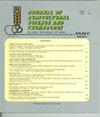水提物对玉米(Zea mays L.)种子黄曲霉侵染的抑制作用
IF 1.3
4区 农林科学
Q2 AGRICULTURE, MULTIDISCIPLINARY
引用次数: 0
摘要
黄曲霉与真菌攻击储存的玉米种子有关。据报道,红血球具有抗真菌作用,可以保护一些作物免受真菌的侵害。本研究旨在评价沙瓦莲叶水提物和茎皮水提物在应用6个月后对黄曲玉米种子品种的抗真菌保护作用。将水浸提液分别以1、10和100%的浓度分别施用于4个不同品种的玉米种子(OBA 98、OBA Super 6、SAMAZ 52和SAMAZ 47),并与玉米种子一起贮存6个月。在马铃薯葡萄糖琼脂(Potato Dextrose Agar, PDA)培养基上,分别放置有提取物组和未施用提取物组的玉米种子,在28℃下培养48小时,测定真菌的生长情况。结果表明,在不同浓度(1、10和100%)施水提物的玉米种子中,黄曲霉未生长,与未施水提物的玉米种子不同,说明黄曲霉生长的发生率较高。综上所述,在不同浓度的1、10和100%条件下,即使在施用6个月后,suaveens叶和茎皮水提取物也显示出对黄曲霉的有效抗真菌剂。本文章由计算机程序翻译,如有差异,请以英文原文为准。
Assessment of Erythrophleum suaveolens (Brenan) leaves and stem bark water extracts antifungal potency on Aspergillus flavus incidence from maize (Zea mays L.) seeds
Aspergillus flavus has been associated with fungi attacks on stored maize seeds. Erythrophleum suaveolens had been reported to have antifungal properties which could protect some crops against fungi attack. This study aimed at evaluating the antifungal protection potency of both water extract of E. suaveolens leaves and stem bark on maize seeds varieties from A. flavus attack post six months of its application. Water extract of E. suaveolens leaves and stem barks (1, 10 and 100% concentration) were independently applied on four different varieties of maize seeds (OBA 98, OBA Super 6, SAMAZ 52 and SAMAZ 47) and stored alongside maize seeds without the extract application for 6 months. The fungal growth determination was carried out on Potato Dextrose Agar (PDA) media plates by placing maize seeds from both the group to which the extract was applied and those without the extract and incubating at 28 °C for 48 hours. The results indicated that all the maize seeds that the E. suaveolens leaves and stem bark water extract was applied at a varying concentration (1, 10 and 100%), recorded no growth of A. flavus unlike the maize seeds without the water extracts application which shows the incidence of A. flavus growth. In conclusion, E. suaveolens leaves and stem bark water extracts under varying concentration of 1, 10 and 100% had demonstrated to be an effective antifungal agent against A. flavus even after 6 months post application.
求助全文
通过发布文献求助,成功后即可免费获取论文全文。
去求助
来源期刊

Journal of Agricultural Science and Technology
AGRICULTURE, MULTIDISCIPLINARY-
CiteScore
1.90
自引率
8.30%
发文量
0
审稿时长
4.5 months
期刊介绍:
Journal of Agricultural Science and Technology is one of the TMU Press journals that is published by the responsibility of its Editor-in-Chief and Editorial Board in the determined scopes.
Journal of Agricultural Science and Technology (JAST) is an international research journal published bimonthly for the purpose of advancing the scientific studies. The subjects covered by JAST include all aspects of agriculture and natural resources (see Areas Covered). The journal will consider submissions from all over the world, on research works not being published or submitted for publication towards publication as full paper, review article and research note. The Papers are published in English with an extra abstract in Persian.
 求助内容:
求助内容: 应助结果提醒方式:
应助结果提醒方式:


